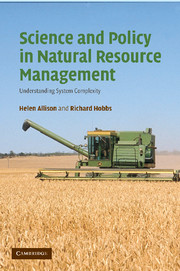Book contents
- Frontmatter
- Contents
- List of illustrations
- List of tables
- Foreword
- Preface
- Acknowledgements
- List of abbreviations
- 1 Introduction
- 2 Historical and policy context
- 3 Natural resource degradation: a resistant problem of the twentieth century
- 4 The epistemology of natural resource management of the twentieth century
- 5 A contemporary epistemology and framework for natural resource management of the twenty-first century
- 6 Model conceptualisation of the Western Australian agricultural region. Part 1: resilience analysis
- 7 Model conceptualisation of the Western Australian agricultural region. Part 2: system dynamics
- 8 Synthesis
- Epilogue
- Glossary
- References
- Index
8 - Synthesis
Published online by Cambridge University Press: 01 March 2010
- Frontmatter
- Contents
- List of illustrations
- List of tables
- Foreword
- Preface
- Acknowledgements
- List of abbreviations
- 1 Introduction
- 2 Historical and policy context
- 3 Natural resource degradation: a resistant problem of the twentieth century
- 4 The epistemology of natural resource management of the twentieth century
- 5 A contemporary epistemology and framework for natural resource management of the twenty-first century
- 6 Model conceptualisation of the Western Australian agricultural region. Part 1: resilience analysis
- 7 Model conceptualisation of the Western Australian agricultural region. Part 2: system dynamics
- 8 Synthesis
- Epilogue
- Glossary
- References
- Index
Summary
Paradigms are the sources of systems.
Donella Meadows, 1999This chapter summarises the findings of the previous chapters and we discuss their implications for natural resources management in the WA agricultural region and in general. We outline the key areas in which changes are taking place in our understanding of science in response to the complex issues of the impacts of human activity on the natural environment. Many of the most serious global impacts, including natural resource degradation, have emerged from the interaction of human activities in the scientific–technical–industrial system. The need for change to more sustainable practices is now well recognised in order to manage the negative impacts caused by the linkages across large temporal and spatial scales (Lubchenco, 1998; Jasanoff et al., 1997), and new directions in science have emerged to meet this challenge (Forrester, 1971; Holling et al., 2002a; Ravetz, 2002). Post-normal science, with a new epistemology, has been developed to help us understand complexity within the social context. This paradigmatic shift currently taking place in science is contributing to the development of theory and practice: in particular the challenge for scientists in conceptualising and understanding the dynamics of large-scale social-ecological systems (SESs), and the challenge for land managers attempting to practise sustainable natural resource management embedded within the SES. We show how the integration of the theories of resilience and system dynamics can help to understand the dynamics of the WA agricultural region as a SES to investigate places in the whole system that might be sensitive to policy intervention and management.
- Type
- Chapter
- Information
- Science and Policy in Natural Resource ManagementUnderstanding System Complexity, pp. 177 - 201Publisher: Cambridge University PressPrint publication year: 2006
- 1
- Cited by

